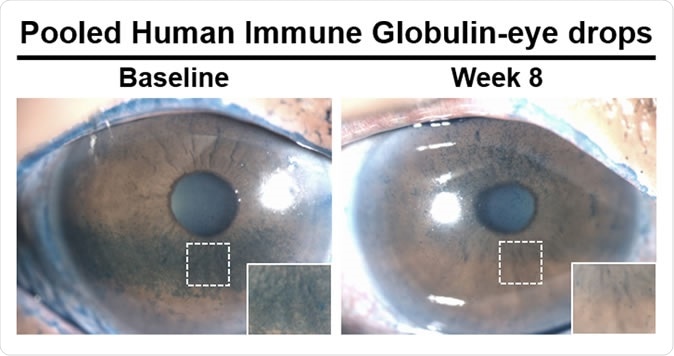Dry eye is a condition wherein a person doesn’t have enough tears to lubricate the eye. With the chronic lack of sufficient lubrication, moisture, and nourishment on the eye, it can lead to eye irritation, inflammation, and eventually, scarring.
Also dubbed as dry eye syndrome, or dry eye disease, the condition is common and often a chronic problem, especially in older people. Commonly, doctors prescribe artificial tears to provide relief for dry eye syndrome.
Now, a team of researchers at the University of Illinois in Chicago had identified the presence of an antibody, known as anti-citrullinated protein autoantibodies (ACPA), in human tears. This is the first time that researchers have shown that patients with dry eye disease experienced relief and decreased signs and symptoms of the illness when they tried a new eye drop treatment.

Patients treated with antibody-based eye drops saw reduced amounts of dry areas (blue spots) on the surface of the eye after eight weeks. Image Credit: Sandeep Jain, et al
Eye drops with antibodies show promise for dry eye disease
In the study published in the journal The Ocular Surface, the team used pooled human antibodies that target ACPAs on the patients and has shown efficacy in battling dry eye syndrome. Though the study is still in its early stage clinical trial, it shows promise and may lead to the formulation of a commercially-available and effective eye drops for patients.
“The burden of autoimmune dry eye is much greater than just having an occasional feeling of dryness. It can severely compromise the quality of life to the point of disability and can compromise a person's vision,” Dr. Sandeep Jain, UIC professor of ophthalmology and visual sciences at the College of Medicine, said.
Dry eye is commonly caused by certain abnormalities in the tear fluid. The condition leads to dry areas on the cornea, the eye surface and the transparent outer layer of the eye. Gradually, if the lack of tears continues, it can lead to disabling eye pain and sensitivity to light in worse cases.
Neutrophils and dry eye disease
In a past study, the researchers found that DNA strands force out from neutrophils, a form of white blood cells, to create webs on the eye surface, which is affected by dry eye disease. As a result, inflammation ensues.
In the present study, they were able to identify that ACPAs also cause eye inflammation, hence, contributing to the formation of these webs. The good news is, the new eye drops they’ve formulated can help reduce inflammation and treat dry eye disease, by cutting the cycle of inflammation.
Novel eye drops show promise
The new eye drops were formulated with the use of polled antibodies, which were created from immune globulins made from donated blood of thousands of participants. All the samples contained many types of antibodies, which can combat the negative effects of the ACPAs.
They tried the eye drops on 27 participants with severe dry eye disease. They were divided into two groups; one was given eye drops made from pooled antibodies. The researchers advised them to put one drop into each eye two times a day for two months. On the other hand, the other group was given the same instructions, but they will use the eye drops without the antibodies.
To monitor and track the patients’ recovery and symptoms, they were given questionnaires. The researchers also evaluated the extent of corneal damage at two months, compared to the group without antibodies in their eye drops. Pro-inflammatory biomarkers were also taken into consideration.
Those with antibody-based eye drops had reduced corneal damage than those in the control group. Also, there were fewer symptoms on the group with the antibody-based eye drops than those who used the eye drops without antibodies.
The participants felt less eye discomfort. The new findings will pave the way for the formulation of new eye drops to finally treat and reduce corneal damage in patients with dry eyes.
Journal reference:
Kwon, J., Surenkhuu, B., Raju, I., Atassi, N., Mun, J., FanChen, Y., Sarwar, M.A., Rosenblatt, M., Pradeep, A., An, S., Dhall, N., Mun, C., and Jain, S. (2019). Pathological consequences of anti-citrullinated protein antibodies in tear fluid and therapeutic potential of pooled human immune globulin-eye drops in dry eye disease. The Ocular Surface. https://www.sciencedirect.com/science/article/abs/pii/S1542012419303775?via%3Dihub